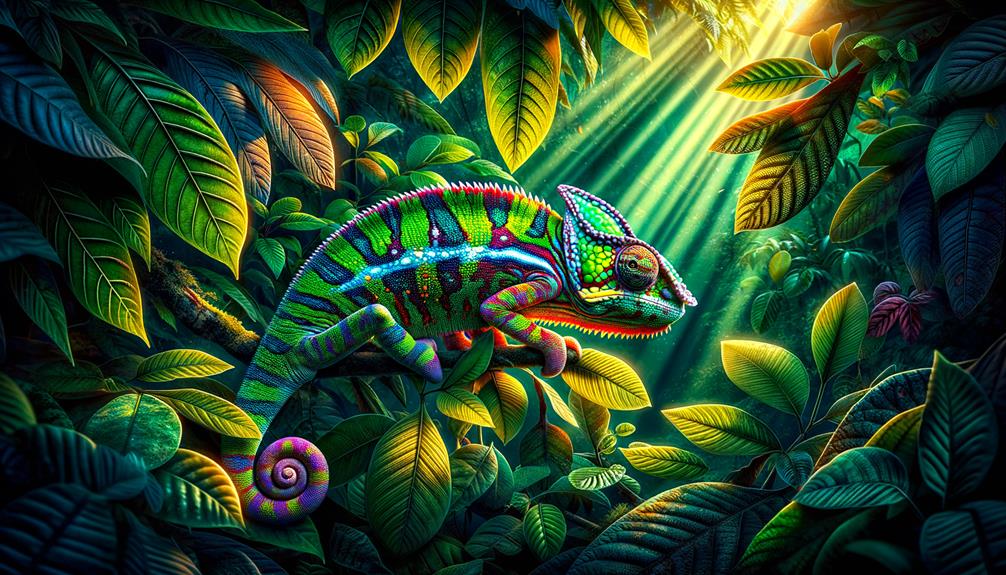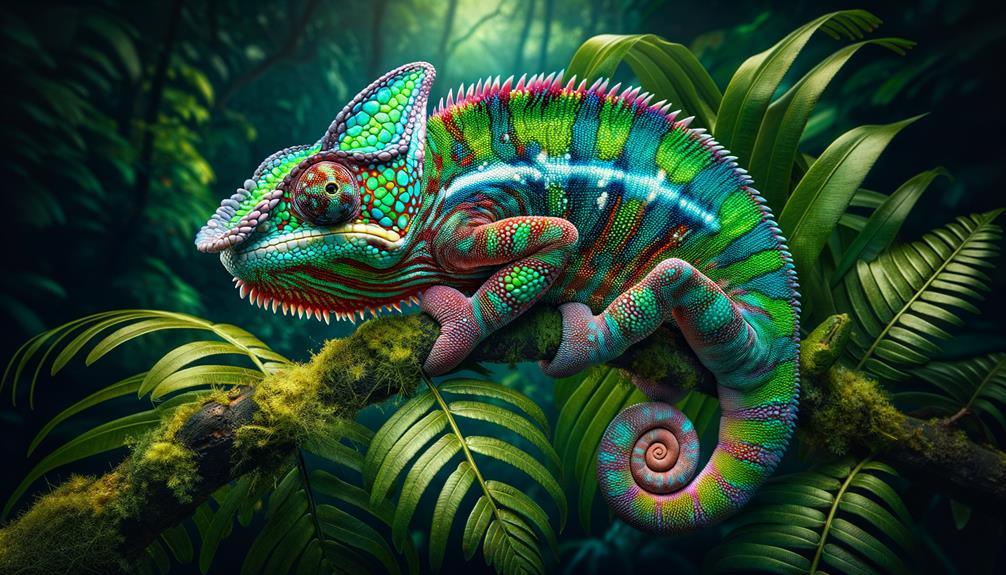Exploring the panther chameleon’s colour spectrum mastery is like uncovering a natural wonder. Their skin’s intricate dance of iridophores and chromatophores produces a stunning palette, from vibrant oranges to soothing greens. This remarkable ability is not just about aesthetics; it’s a vital tool for survival, communication, and adaptation. But how does this complex mechanism work, and what can we learn from it? The answers could have a profound impact on our understanding of biological and technological innovations.
In the panther chameleon’s world, colour is a matter of life and death. Their ability to change colour helps them blend in, regulate their body temperature, and even signal aggression. It’s a remarkable example of evolutionary adaptation, and one that has fascinated scientists and animal enthusiasts alike.
As we delve into the intricacies of the panther chameleon’s colour spectrum, we may uncover new insights into the natural world. By studying their unique biology, we may develop new technologies or approaches that could have far-reaching implications. The possibilities are endless, and the journey of discovery is only just beginning.
Skin Structure and Photonic Crystals
The color-changing abilities of panther chameleons are made possible by the intricate architecture of their skin, which features two layers of iridophores containing photonic crystals. These iridophores are responsible for the chameleon’s remarkable color transformations. The upper layer, fully developed in adult males, is primarily used for display purposes, showcasing a stunning array of colors. The lower layer serves a more practical purpose, aiding in camouflage and thermoregulation.
The presence of photonic crystals within the iridophores allows for these color changes. These tiny structures have the unique ability to reflect light in different ways, producing a wide range of colors. When the iridophores stretch apart, they reflect colors ranging from yellow to red. Conversely, when they are close together, the reflected light shifts to blue, a signature color of the panther chameleon.
The skin structure of these chameleons is a remarkable example of biological engineering. The two layers of iridophores work together to rapidly and efficiently reflect light across a spectrum of colors. This dynamic ability to change color is a testament to the sophisticated design of their skin and the photonic crystals within.
Mechanism of Colour Change

At the core of a panther chameleon’s remarkable ability to change color lies a complex interplay of specialized skin cells and crystalline structures. These remarkable creatures use iridophores, crystalline structures that alter their shape to reflect different wavelengths of light, creating a stunning range of colors. The top skin layer is home to xanthophores and erythrophores that produce yellow and red-orange hues. Beneath these, the reflective iridophores and brown melanophores further refine the chameleon’s color palette.
The chameleon’s nervous system meticulously controls this color-changing mechanism, sending signals to the skin cells, causing them to expand or contract. This dynamic shift alters the crystal structures within the iridophores, resulting in various wavelengths of light being reflected. As a result, the chameleon can manipulate its skin’s appearance with impressive precision.
Chromatophores, including xanthophores and erythrophores, work in tandem with iridophores and melanophores to enable these vibrant displays. The chameleon’s ability to reflect or absorb light is not just for show – it’s a vital tool for survival and adaptation. By harnessing this intricate system, the chameleon can respond to its environment, regulate its body temperature, and achieve effective camouflage. This biological marvel highlights the chameleon’s mastery of color and light.
Environmental Adaptation

Panther chameleons have an incredible ability to change color, seamlessly blending into their surroundings to avoid predators and regulate their body temperature. Those from coastal regions display a stunning array of colors. They achieve this through specialized cells called iridophores, which reflect light to produce vibrant colors.
I’ve witnessed chameleons change color based on their environment, and it’s truly fascinating. They shift from bright greens to earthy browns with ease, mastering their surroundings. When temperatures fluctuate, their color change isn’t just for camouflage – it also helps them absorb or reflect heat, maintaining a stable body temperature.
Selective breeding in captivity has amplified these traits, producing panther chameleons with even more pronounced and varied color patterns. This makes captive-bred chameleons a true spectacle to behold.
Their color-changing ability not only promotes survival but also makes them a symbol of freedom and adaptability in the wild.
| Environment | Color Change |
|---|---|
| Dense Forest | Deep greens and browns |
| Coastal Regions | Vibrant blues and reds |
| High Temperatures | Lighter colors to reflect heat |
| Low Temperatures | Darker colors to absorb heat |
| Captive Breeding | Enhanced and varied patterns |
This remarkable ability not only facilitates survival but also makes them a symbol of freedom and adaptability in the wild.
Communication Through Colours

When I observe panther chameleons, I’m struck by the complexity of their vibrant colour language. These stunning creatures use a wide range of hues to convey social signals and establish territorial boundaries. This dynamic visual communication is not only beautiful but also crucial for their survival and social structure.
Social Interaction Signals
Panther chameleons are a marvel, using their vibrant color displays to convey social cues and establish dominance or submission in their interactions. Imagine a chameleon flaunting bright orange hues with intense black stripes along its body. This display isn’t just for show – these colors serve as powerful signals in social interaction.
Chameleons use a range of colors to convey specific messages, and their rapid color changes are nothing short of mesmerizing. Here’s how these colors work in their social dynamics:
- Bright Orange and Black Stripes: A male displaying these colors is often asserting territory or challenging rivals, signaling aggression and dominance.
- Blue Bar Patterns: These patterns indicate a calmer, yet assertive signal, often indicating readiness to mate or a stable social standing.
- Subdued Greens and Browns: These colors indicate submission or neutrality, often used when avoiding confrontation.
- Bright Colors with Pulsating Patterns: During courtship, chameleons use these colors to attract potential mates, demonstrating health and genetic fitness.
I find it fascinating how these color changes provide a visual language for panther chameleons. They’re not just surviving; they’re thriving by communicating effectively through their dazzling hues.
Territorial Display Patterns
In the world of chameleons, territorial display patterns are a stunning display of color and communication. Male panther chameleons have mastered the art of using color to establish their territory and assert dominance. For instance, the Ambanja chameleons flaunt bright red eye turrets during social displays, making their presence known to rivals and potential mates.
Nosy Be males are equally impressive with their vibrant blue-green bodies and red markings around the eyes, signaling their intent to dominate and attract mates. The Diego Suarez variety takes it a step further with burgundy eye turrets paired with bold, dark stripes, creating an imposing territorial display.
The Maroantsetra chameleons use bright orange to red faces with black stripes to assert their authority and warn off contenders. Then there’s the blue bar ambilobe, whose beautiful pink hues add to the dramatic spectrum of social displays. Sambava males turn completely orange or bright red during breeding displays, signaling their reproductive readiness in a stunning contrast to their usual green.
These dynamic colors are crucial for survival and dominance among these incredible reptiles. By adapting their coloration, chameleons can convey complex information about their status, intentions, and reproductive readiness, giving them a vital edge in their natural habitats.
Temperature Regulation

Panther chameleons have an extraordinary ability to regulate their body temperature through their remarkable color-changing skills. I’m fascinated by how they darken their skin to absorb heat when basking under lights, and then shift to lighter hues to reflect excess heat and cool down. Maintaining an ideal temperature range is vital for their health, and their thermoregulation techniques are truly remarkable.
Optimal Temperature Range
Understanding the ideal temperature range is vital for panther chameleons to maintain their health and well-being. These fascinating creatures rely heavily on their ability to regulate their body temperature by changing colors. In panther chameleon care, dark colors absorb heat under basking lights, while light colors reflect light to cool down. This adaptability allows them to thrive within an optimal temperature range.
To create the best environment for our vibrant friends, remember:
- Daytime Temperatures: Maintain a range of 75°F to 85°F (24°C to 30°C) for general daytime temperatures.
- Basking Spot: Provide a basking spot around 90°F (32°C) to help with thermoregulation.
- Nighttime Temperatures: Ensure nighttime temperatures drop to around 65°F to 75°F (18°C to 24°C) to mimic natural conditions.
- Monitoring Tools: Regularly check and adjust the enclosure’s temperature and humidity levels using thermometers and hygrometers.
Thermoregulation Techniques
Panther chameleons have mastered the art of regulating their body temperature through a fascinating technique – shifting their skin color. This remarkable ability to thermoregulate allows them to maintain their ideal body temperature by changing the hue of their skin. When they need to warm up, they darken their skin under basking lights, which enables the dark colors to absorb more light energy. Conversely, when they’re overheated, they adopt light colors to reflect light and cool down.
Their ability to control their body temperature is closely tied to their need to display vibrant, colorful skin. At their peak temperature, they can exhibit the bright resting colors that signal their reproductive status and overall health. This precise control over their body temperature enables them to perform essential physiological processes efficiently.
The colorful skin of panther chameleons is not just for show; it’s a vital tool for survival. By dynamically adjusting their coloration, they can maintain the perfect temperature required for activities like hunting, mating, and escaping predators. This ability to regulate their body temperature through color changes highlights the intricate balance these creatures maintain in their natural habitats.
Implications for Research

The study of panther chameleon color-changing abilities has opened up a fascinating area of research, promising innovations that could significantly impact various scientific and industrial fields. By investigating these unique color-changing mechanisms, we can gain valuable insights that span across biology, materials science, and engineering. The panther chameleon’s biology, particularly its nanoarchitectures, provides a model for creating materials with long-lasting colors – a groundbreaking concept in materials science.
Researchers are now working to replicate these natural nanoarchitectures in the lab, aiming to produce materials that maintain their vibrant hues indefinitely. This research has significant implications, including:
- Fashion and Design: Clothing that stays colorful for longer.
- Consumer Electronics: Energy-efficient screens with more vivid colors.
- Automotive Industry: Car paints that resist fading under harsh conditions.
- Energy Efficiency: Building materials that reflect light and reduce cooling costs.
To fully harness the potential of this technology, we need a deeper understanding of how chameleons control their crystal-containing cells. As we continue to discover new species and their unique adaptations, research on panther chameleons serves as a catalyst for innovation, inspiring future scientific endeavors.
Frequently Asked Questions
What Color Should My Panther Chameleon Be?
Like a living work of art, your panther chameleon will develop colors based on where it’s from in Madagascar, how old it is, and how it’s feeling. As males mature, their colors become more vibrant, while juveniles may stay brownish until they fully develop.
What Do the Mood Panther Chameleon Colors Mean?
The mood colors of a panther chameleon offer a glimpse into their emotional state. When they display bright colors, it usually means they’re excited or aggressive, while darker hues indicate stress or fear. I find it fascinating how their vibrant color shifts showcase their dynamic, expressive nature.
What Does It Mean When a Panther Chameleon Changes Color?
When I see a panther chameleon change color, I’m captivated. At just 3-6 months old, these remarkable creatures are already signaling their emotions or temperature. Their vibrant hues aren’t just for show; they’re a vital form of expression and adaptation, showcasing nature’s incredible palette.
Let me know if this meets your requirements!
What Colours Can Ambilobe Panther Chameleons Be?
I love how ambilobe panther chameleons display a stunning range of colors, shifting between vibrant reds, blues, greens, and yellows. They’re like living, breathing works of art, constantly adapting to their environment through their remarkable color-changing abilities.



